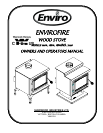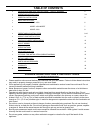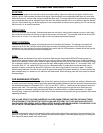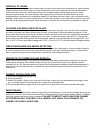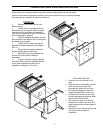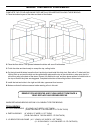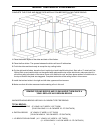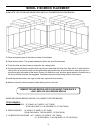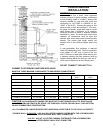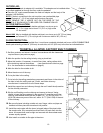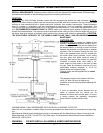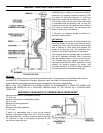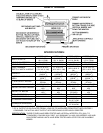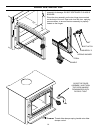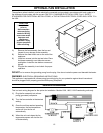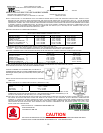
DISPOSAL OF ASHES:
If you let the ashes accumulate two or three inches on the floor they tend to burn themselves up. Open the small
trap door located on the floor of the unit. Push the ashes that have accumulated into the hole were the ashes
would drop into the ash pan. Ensure that the trap door is closed properly before relighting the unit. When
necessary put the ashes in a metal container with a tightly fitting lid. Place the closed container on a non-
combustible floor, well away from combustible materials. If the ashes are to be buried in soil or otherwise locally
dispersed, keep them in a closed container until all cinders have cooled. If your model has an ash pan, be sure to
latch the ash pan tightly when finished. Small amounts of cold wood ash can be used in the garden or compost.
CLEANING AND REPLACING THE GLASS:
Normally a hot stove will keep the glass clean, but if you must clean the glass, use a soft cloth with no abrasive
and clean only when cold. Never strike or slam the door, hit the glass or let burning wood rest against it. If the
glass cracks when the fire is burning, do not open the door until the fire is out and do not operate the stove again
until the glass has been replaced, preferably by your dealer. To remove the door, open and lift. To replace the
glass, remove the steel retaining clips and all loose glass. Replace only with Neoceram 5 mm glass 16.61” (422
mm) x 10.63” (270 mm) and wrap the edges with 0.125” (3.2 mm) x 0.5” (13 mm) self-adhesive fiberglass gasket.
FIRE EXTINGUISHER AND SMOKE DETECTION:
All homes with a solid fuel burning stove should have at least one fire extinguisher in a central location known to
all in the household, and at least one smoke detection devise in the room containing the stove. If it sounds the
alarm, correct the cause but do not deactivate or relocate the smoke detection devise.
CREOSOTE- ITS FORMATION AND REMOVAL:
When wood is burned slowly, it may produce tar and other vapors that combined with moisture form creosote.
These vapors condense in the relatively cooler chimney flue of a slow burning fire, and if ignited, make an
extremely hot fire. So, the smoke pipe and chimney should be inspected bi-weekly during the heating season to
determine if a build-up has occurred. If creosote has accumulated it should be removed to reduce the risk of a
chimney fire.
CHIMNEY OR RUN AWAY FIRE:
1. Call local fire department (or dial 911)
2. Close the draft fully
3. Examine flue pipes, chimney, attic, and roof of the house, to see if any part has become hot enough to catch
fire. If necessary spray with fire extinguisher or water from the garden hose.
4. Do not operate the stove again until you are certain the chimney and its lining have not been damaged.
MAINTENANCE:
At the end of each heating season clean the chimney and the smoke pipe. If soot has accumulated above the top
baffle bricks, remove, clean, and then replace them. If the secondary air tube is badly eroded, replace it. Replace
worn door gaskets and broken bricks as needed.
FAILURE TO INSPECT AND CLEAN YOUR CHIMNEY
SYSTEM REGULARLY CAN RESULT IN A CHIMNEY FIRE, WHICH COULD DAMAGE THE
CHIMNEY OR CAUSE A HOUSE FIRE.
4



